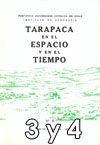The mita of Tarapacá in the XVIII Century
Keywords:
geografía humana, geografía cultural, Tarapacá, mineriaAbstract
The resumption of work at the Huantajaya silver ore mine, near Iquique, in the middle of the eighteenth century, led to a greater demand for labor. In order to attend these works, the indigenous mita was established for the first time in Tarapacá, which, in the end, was destined to the work of milling silver in the Tilivilca Settlement, Tarapacá ravine. The file for the settlement. The dossier for the settlement and the agreements between the beneficiary and the Indians; it was found at the bottom of a gallery of the Huantajaya mine last century and is now being studied for the first time. This document constitutes an important source for the knowledge of the population and the working conditions in the area.
Downloads
References
LARRAIN, HORACIO, 1974.-"Andlisis de las causas de despoblamiento entre las comunidades indígenas del Norte de Chile con especial referencia a las hoyas hidrográficas de la$ quebradas Aroma Tarapacá Norte Grande, Vol. 1. No 2, Instituto de Gy afta Universidad Cat6iica de Chile, diciembre 1974, 125-154, Santiago de Chile













